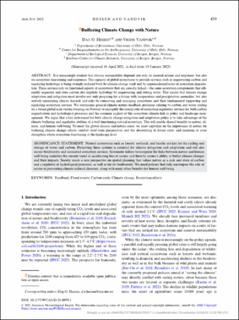| dc.contributor.author | Hessen, Dag Olav | |
| dc.contributor.author | Vandvik, Vigdis | |
| dc.date.accessioned | 2023-02-06T12:36:19Z | |
| dc.date.available | 2023-02-06T12:36:19Z | |
| dc.date.created | 2022-08-07T21:26:50Z | |
| dc.date.issued | 2022 | |
| dc.identifier.issn | 1948-8327 | |
| dc.identifier.uri | https://hdl.handle.net/11250/3048568 | |
| dc.description.abstract | It is increasingly evident that climate sustainability depends not only on societal actions and responses, but also on ecosystem functioning and responses. The capacity of global ecosystems to provide services such as sequestering carbon and regulating hydrology is being strongly reduced both by climate change itself and by unprecedented rates of ecosystem degradation. These services rely on functional aspects of ecosystems that are causally linked—the same ecosystem components that efficiently sequester and store carbon also regulate hydrology by sequestering and storing water. This means that climate change adaptation and mitigation must involve not only preparing for a future with temperature and precipitation anomalies, but also actively minimizing climate hazards and risks by conserving and managing ecosystems and their fundamental supporting and regulating ecosystem services. We summarize general climate–nature feedback processes relating to carbon and water cycling on a broad global scale before focusing on Norway to exemplify the crucial role of ecosystem regulatory services for both carbon sequestration and hydrological processes and the common neglect of this ecosystem–climate link in policy and landscape management. We argue that a key instrument for both climate change mitigation and adaptation policy is to take advantage of the climate buffering and regulative abilities of a well-functioning natural ecosystem. This will enable shared benefits to nature, climate, and human well-being. To meet the global climate and nature crises, we must capitalize on the importance of nature for buffering climate change effects, combat short-term perspectives and the discounting of future costs, and maintain or even strengthen whole-ecosystem functioning at the landscape level. | en_US |
| dc.language.iso | eng | en_US |
| dc.publisher | American Meteorological Society | en_US |
| dc.title | Buffering climate change with nature | en_US |
| dc.type | Journal article | en_US |
| dc.type | Peer reviewed | en_US |
| dc.description.version | publishedVersion | en_US |
| dc.rights.holder | Copyright 2022 American Meteorological Society | en_US |
| cristin.ispublished | true | |
| cristin.fulltext | original | |
| cristin.qualitycode | 1 | |
| dc.identifier.doi | 10.1175/WCAS-D-21-0059.1 | |
| dc.identifier.cristin | 2041551 | |
| dc.source.journal | Weather, Climate, and Society | en_US |
| dc.source.pagenumber | 439-450 | en_US |
| dc.relation.project | Norges forskningsråd: 294948 | en_US |
| dc.relation.project | Norges forskningsråd: 315249 | en_US |
| dc.identifier.citation | Weather, Climate, and Society. 2022, 14 (2), 439-450. | en_US |
| dc.source.volume | 14 | en_US |
| dc.source.issue | 2 | en_US |
